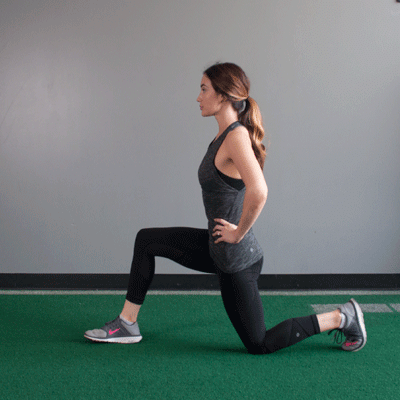Flexibility is an important part of fitness and overall health. Daily activities would be much more challenging without the ability to bend over, twist, or squat.
By incorporating a stretching program into your daily routine, you can increase your flexibility and range of motion. You can also improve performance in sports and daily tasks. Stretching can help prevent injury and decrease pain associated with muscle tightness.
Try this five-minute exercise routine today to prepare you for the busy day ahead, or to get some much needed relaxation after work.
This stretch is great for the lower body, especially the hamstrings and hip flexors. Tight hamstrings are often the culprits of low back pain. They may be worse in people who sit for extended periods of time.
Equipment needed: none
Muscles worked: hamstrings, hip flexors, low back, calves
- Stand with your feet hip-width apart.
- Step back with your left leg and place both of your hands on the ground on either side of your right foot, about shoulder-width apart.
- Lower your hips until you feel a stretch in the front of your left hip and leg. Hold for 30 seconds.
- Slowly straighten your front leg, keeping your hands planted on the floor. Don’t worry if you can’t get your leg completely straight. Hold for 30 seconds.
- Repeat on the other side.
This stretch is the ultimate full body stretch. It’s ideal for office workers who spend too much time sitting at a computer. This will stretch the legs and hamstrings. It’s also a chest and shoulder opening exercise.
Equipment needed: none
Muscles worked: hamstrings, shoulders, low back, chest
- Stand with your feet hip-width apart, toes pointing forward.
- Reach your hands behind you to meet behind your glutes. Interlace your fingers, if possible.
- Keeping a flat back, bend at the waist, shifting your hips backward and weight in your heels until you feel a stretch down the back of your legs.
- As you bend forward, let gravity pull your arms above your head, keeping your arms straight. Only go as far as your shoulder flexibility will allow. Hold this position for 30 seconds.
- Repeat.
Spinal twists are a great release exercise: They can help improve back pain and increase mobility. If you have any disk or spinal problems that may worsen with twisting, skip this exercise.
Equipment needed: none
Muscles worked:erector spinae, glutes, low back
- Sit on the floor, legs crossed with your left leg on top.
- Cross your left leg further over your right leg, placing your foot on the ground by your right knee so that your left knee is pointing upward.
- Gently twist your shoulders toward the left, pushing against your left leg for leverage.
- Only go as far as comfortable. Hold position for 30 seconds.
Repeat on other side.
This hip opening stretch is effective for both men and women. It helps decrease tension in the hips and muscles on the inside of the thighs.
Equipment needed: none
Muscles worked: adductors, hip flexors, glutes
- Sit on the floor, back straight. Keep the soles of the feet touching.
- Place your hands on your feet and lengthen through the spine. Feel as if there is a string pulling your head to the ceiling and shift your weight forward off your tailbone.
- Using your arms to assist, lean forward with a flat back, bringing your head toward your feet.
- Only go as far as comfortable. Hold position for 30 seconds.
Tightness in the chest and shoulders is often found in people with poor posture. This can lead to bigger problems later in life. Doing daily chest-opening stretches can help prevent tightness and promote proper posture and better breathing.
Equipment needed: doorway
Muscles worked: chest, anterior deltoid, biceps
- Stand in the middle of an open door.
- Place your forearms on each side of the doorframe, if possible. If the doorway is too wide, do one arm at a time.
- Gently lean forward into the doorway until you feel a stretch through the front of the chest and shoulders.
- Only go as far as comfortable. Hold position for 30 seconds.
Stretching for only a few minutes a day can be beneficial and allow you to keep your normal range of motion throughout your life.
For those who are active, it may be best to do your stretches after you work out. For everyone, try incorporating these stretches today to help improve your flexibility and ward off back pain and poor posture in the future.
Should you stretch before or after exercise?Stretching is best after physical activity. Pre-exercise stretching is likely not beneficial to sport performance.

